REVOLUTIONARY GEOMETRY: A Foundation for Nature-Based Architecture
by JAMES JACOBS
July 2003
page 1
| 2
How Helical Geometry Demonstrates Correspondence with the Source of Symmetry in Nature.
A nature-based way of designing and building begins with a nature-based geometry. Helical Geometry is structural biomimicry, that is, its forms structurally mimic the natural form of a soap film.
The helical form is universal, existing in every form of matter. From the microcosmic, atomic structure of crystal growth to the molecular structure of DNA to the macrocosmic spiral form of galaxies, all structure in matter mimics the source of symmetry in Nature. Uncovering the 3-dimensional geometry of the helical form in Nature, then, is to uncover the 3-dimensional source of the symmetry in nature.
Soap films exemplify an important mathematical idea called a minimal surface. Soap films form minimal surfaces because the energy of surface tension in a soap film is proportional to its area. Nature always minimizes energy expenditure, so soap films minimize area. For example, the natural form of a soap film represents the surface of smallest area within a framework of Plexiglas tubes.
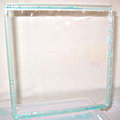 |
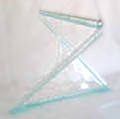 |
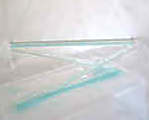 |
|
Fig. 7 The structural properties of
the helical soap-film |
||
 |
|
|
Fig. 8 The helical edge |
|
Structurally mimicking the properties of a soap film stretched within a framework of Plexiglas tubes demonstrates the natural basis for Helical Geometry. When a soap film is suspended within a framework of Plexiglas tubes that are strung like long cylindrical beads we are able to observe its structural properties (Fig. 7).
At first glance the warped surfaces of the soap film appear to resemble the familiar form called the hyperbolic-paraboloid, a saddle-shaped surface generated by straight rods. But a significant difference is seen under closer observation. The outer edges of the soap film, where it adheres to the Plexiglas tubes, have a helical form. The minimal surface of the soap film's edges twists around the Plexiglas tubes (Fig. 8). This is the structural property of the natural surface form of a soap film that distinguishes it from the hyperbolic-paraboloid, whose outer edges are straight rods.
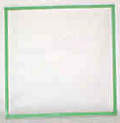 |
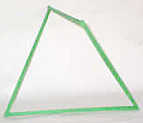 |
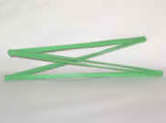 |
|
Fig. 9 Structurally mimicking
the helical edges of the soap-film. |
||
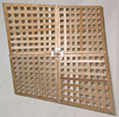 |
|
|
Fig. 10 |
|
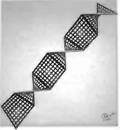 |
|
|
Fig. 11 |
|
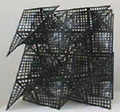 |
|
|
Fig. 12 |
We can mimic this helically edged property of the natural soap film form using a framework of flat, twistable rods or struts. (Fig. 9) We can then mimic the surface form of the soap film by extending flat, twistable struts between the opposing helical edges of the framework. (Fig. 10). [Note the four kite-shaped forms that generate the full helical framework by their 4-fold rotation]. The resulting system of "soap film rigid structures" may now be seen as segments or units of linear helical structures, rather than as independent saddle-shapes. Linear helical structures are generated by matching the helical edges of the helical units. (Figs. 11, 12) These helical units are the basic elements of Helical Geometry, a structure system that mimics natural helical form.
It was the fourfold rotation in 2-dimensional space of the plane right-angled triangle that generated the natural 2-dimensional symmetry of the plane square in Pythagoras's demonstration of the correspondence of the plane right-angled triangle with the source of symmetry in Nature. (Fig. 5). Likewise, it is the fourfold rotation in 3-dimensional space of the kite-like helical building panel (Fig. 6), that generates the 3-dimensional helical geometric structure that mimics the symmetry of the soap film. (Fig. 7) This demonstrates the correspondence of the elements of Helical Geometry with the source of symmetry in Nature. The kite-like helical building panels are like 3-dimensional right-angled triangles.
How Helical Geometry Incorporates Previous Knowledge
"Does it incorporate previous knowledge?" "Does it demonstrate undeniable correspondences with existing knowledge?" These are the crucial questions, the prerequisites, for a valid claim by any new knowledge to an advance in the foundations of existing knowledge. Helical Geometry satisfies these two questions by demonstrating the incorporation of the knowledge represented by the plane right-angled triangle, and by its ability to generate the archetypal forms of Plane and Solid Geometry.
Incorporating the Knowledge of the Plane Right-Angled Triangle
You can point at the shortest edge of any helical building panel
and say, "The length of this shortest edge is the cosine of the
degrees of rotation or twist along its length (Fig. 13)." Likewise,
you can point at the horizontal leg of a plane right-angled triangle
and say, "The length of this shortest edge is the cosine of
the degrees of rotation relative to the hypotenuse (Fig. 14)."
Helical Geometry incorporates the knowledge of the plane right-angled
triangle, transforming it into a 3-dimensional concept.
Fig. 13 |
Fig. 14 |
|
|
Cosine distance (blue) |
||
|
The 45° twisting Cosine distance
of the helical building panel (left), and the Plane Right-angled
Triangle (right). |
||
| Hypotenuse (blue) | ||
| Fig. 15 Helical Right Triangle (left), Plane Right Triangle (right) |
||
 |
||
|
Fig. 16
|
||
Helical Geometry's multiple kite-like helical building panels each represents a cosine ranging from 0 to 90 degrees. The kite-like helical panel represents the number of degrees of rotation by the amount of twist over the length of its shortest edge. And, its length is the cosine of the number of degrees of rotation or twist along the shortest edge. So, for example, the helical building panel in Figures 13 and 14, has 45 degrees of twist or rotation along the shortest edge. And, the length of this shortest edge is the cosine of 45°, or, .7071 in relation to the constant length of the longest edge, which is 1.
This trigonometric relationship is true for all the kite-like helical
building panels: As the length of the shortest edge decreases the
amount of twist, or degrees of rotation, increases, and, the numerical
relationship is the same as that of the Table of Natural Trigonometric
Functions for Sines and Cosines. This table of functions is derived
from the 2-D system of structures, the plane right-angled triangle.
We can liken the hypotenuse of the plane right-angled triangle to
the longest edge of the helical building panel (Fig. 15), and the
horizontal leg of the plane right-angled triangle to the shortest
edge of the helical building panel (Figs. 13, 14). The difference
is that the plane right-angled triangle expresses its degrees of
rotation as a plane angle of rotation between 0 and 90 degrees,
a 2-dimensional representation, while the helical building panel
expresses its degrees of rotation over a distance, a helical angle
of rotation or twist, a 3-dimensional representation. (Fig. 16)
This is why the helical building panels can be called "3-dimensional
right-angled triangles", or "Helical Right Triangles", just
as the 2-dimensional right-angled triangles are called Plane Right Triangles.
Incorporating the Archetypal Structures of Plane and Solid Geometry
Imagine that we had never seen the geometric structures of Plane and Solid Geometry, never seen a circle, square, triangle, sphere, cube or pyramid. If all we knew was Helical Geometry it would reveal to us all of these archetypal geometric structures. And this stands to reason. If Helical Geometry represents an advance in geometrical knowledge, then, it should be able to generate in its geometrical configurations the geometrical structures of Plane and Solid Geometry, the geometries that historically preceded Helical Geometry.
Helical Geometry is a 'field geometry', meaning its helical building panels with lattice surfaces represent a geometrical system of fields having helical, saddle-shaped form. Using the building panels of Helical Geometry we can make models in which the panels intersect one another, matching their helical edges at the intersections. Matching the helical edges means that we are following the "logical rules of connection" inherent in the Helical Geometry panels or fields. A logical connection is one in which the degrees of twist and direction (left or right), and, the corresponding length at the connection of two intersecting or edge-connecting helical panels, match or coincide.
Following these logical rules of connection a configuration can be constructed in which 96 kite-like panels intersect to generate the outward form of two interpenetrating tetrahedrons. Within this configuration of logically intersecting helical fields of form can be seen an empty space. It is a space that is defined by the inner surfaces of the helical fields of form. Looking closer we can see that within the configuration of intersecting fields of helical form has been generated the plane geometry of the circle, square and triangle; and the solid geometry of the sphere, cube and pyramid (Figs. 17, 18). So, while Helical Geometry cannot be generated from Plane or Solid Geometry, Plane and Solid Geometry can be generated from Helical Geometry. Helical Geometry, then, can be said to be "prior to" Plane and Solid Geometry, which is to say it incorporates existing geometrical knowledge and represents an advance in fundamental geometrical knowledge.
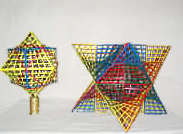 |
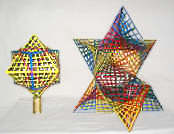 |
|
| Figs. 17, 18 Within Helical Geometry's intersecting tetrahedrons (on right in photos), is generated the archetypal forms of Plane and Solid Geometry (on left) |
||
Helical Geometry represents a foundation for advancement in architectural knowledge. It promises the foundation for visionary applications of advanced architectural design that is organic, ecological and evolutionary. It is a nature-based geometry that embodies a synthesis of form and function. Its varied structural forms promise sensitivity to the environment, simplicity in application and economics, and natural elegance.
Helical Geometry is learned by modeling, by creating constructions using multitudes of one or more types of the kite-like building panels of Helical Geometry. How Helical Geometry has been used to date in modeling and constructions, and instructions on how to fabricate helical building panels for modeling and construction will be subjects of future writings.
. . .
We at ECOTECTURE welcome you feedback. Address
your comments on articles or other matters to editor@ecotecture.com.
If you want them published, put "LETTER TO THE EDITOR" at the top
of the page.
-PSW and the ECOTECTURE Associates